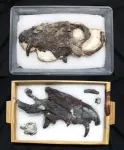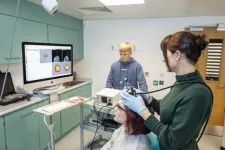(Press-News.org) Dinosaurs have quite the reputation for being the largest, fiercest predators in life’s history. Yet, 40 million years before dinosaurs ruled, Pampaphoneus biccai dominated South America as the biggest and most bloodthirsty meat eater of its time.
In a new study published in the Zoological Journal of the Linnean Society, an international team of researchers reveal the astounding discovery of a 265-million-year-old, exquisitely preserved fossil species, Pampaphoneus biccai, found in the rural area of São Gabriel, Southern Brazil.
The stunning fossil includes a complete skull and some skeletal bones, such as ribs and arm bones. Pampaphoneus, which belongs to the early therapsid clade called dinocephalians, lived just before the largest extinction event in the history of Earth that eliminated 86% of all animal species worldwide.
Before the extinction event, dinocephalians were one of the major groups of large terrestrial animals that thrived on land. They were medium to large-sized creatures with both carnivorous and herbivorous representatives. Dinocephalians had thick cranial bones, which led to the group's name which translates to "terrible head" in Greek. While well-known in South Africa and Russia, these animals are rare in other parts of the world. Pampaphoneus biccai is the only known species in Brazil.
"The fossil was found in middle Permian rocks, in an area where bones are not so common, but always hold pleasant surprises,” said lead author Mateus A. Costa Santos, a graduate student in the Paleontology Laboratory at the Federal University of Pampa (UNIPAMPA). “Finding a new Pampaphoneus skull after so long was extremely important for increasing our knowledge about the animal, which was previously difficult to differentiate from its Russian relatives."
Paleontologists from UNIPAMPA and Universidade Federal do Rio Grande do Sul (UFRGS) collected the fossil over one month of daily, backbreaking fieldwork. Due to the pandemic, it took an additional three years for the fossil to be cleaned and thoroughly studied. Co-author Professor Stephanie E. Pierce, in the Department of Organismic and Evolutionary Biology and Curator of Vertebrate Paleontology and Mammalogy in the Museum of Comparative Zoology at Harvard, participated in the study of the animal as part of her current work with senior author and head of lab Professor Felipe Pinheiro, UNIPAMPA, on the Permo-Triassic fossil record of Brazil.
“This animal was a gnarly-looking beast, and it must have evoked sheer dread in anything that crossed its path,” said Pierce. “Its discovery is key to providing a glimpse into the community structure of terrestrial ecosystems just prior to the biggest mass extinction of all time. A spectacular find that demonstrates the global importance of Brazil’s fossil record.”
The new specimen is only the second Pampaphoneus skull ever discovered from South America. It is also larger than the first and provides unprecedented information about its morphology due to the exceptional preservation of its bones.
“Pampaphoneus played the same ecological role as modern big cats," said Pinheiro. "It was the largest terrestrial predator we know of from the Permian in South America. The animal had large, sharp canine teeth adapted for capturing prey. Its dentition and cranial architecture suggest that its bite was strong enough to chew bones, much like modern-day hyenas."
Although Pampaphoneus’ skull is the largest ever found intact at almost 40cm, research suggests a previously unidentified fossil represents a potential third individual that was up to two times larger than the new find. While the latter is only known from a fragment of its jaw, it does have sufficient characteristics to identify it as Pampaphoneus.
Researchers estimate that the largest Pampaphoneus individuals could reach nearly three meters in length and weigh around 400kg. It was a skilled predator capable of feeding on small to medium-sized animals. In the same locality where the fossil was found, some of its potential prey have also been identified, such as the small dicynodont Rastodon and the giant amphibian Konzhukovia.
The new Pampaphoneus specimen, along with the other animals found in this region, demonstrate the paleontological potential of the Pampa region for significant fossil discoveries.
The work was funded by the Coordenação de Aperfeiçoamento de Pessoal de Nível Superior-Brasil (CAPES), the Conselho Nacional de Desenvolvimento Científico e Tecnológico (CNPq), the Harvard Lemann Brazil Research Fund.
####
END
Climate change and increases in drought and rainstorms pose serious challenges to our water management. Not only the availability of water is under pressure, but also its quality. However, according to the most recent IPCC report our current understanding of this issue is inadequate. To fill this gap, an international group of scientists has brought together a large body of research on water quality in rivers worldwide. The study published in Nature Reviews Earth & Environment shows that river water quality tends to deteriorate during extreme weather events. As these events become more frequent and severe due to climate change, ...
Research team led by Shir Filo and Prof. Aviv Mezer of the Safra Center for Brain Science at the Hebrew University of Jerusalem (ELSC) and Dr. Tal Shahar currently, Director of the Neurosurgical Oncology Unit at the Neurosurgery Department, Tel Aviv Sourasky Medical Center, have unveiled a groundbreaking magnetic resonance imaging (MRI) technology that promises to revolutionize our understanding of iron homeostasis in the human brain. Their research, demonstrates the ability to non-invasively assess different molecular iron environments within the brain, shedding light on its vital role in normal brain function, aging, neurodegenerative ...
The University of Manchester will partner with the Martingale Foundation to improve postgraduate access to STEM subject through a fully funded scholarship.
The University is one of three new universities chosen to partner with the Martingale Postgraduate Foundation to support passionate and talented students facing financial barriers to pursue postgraduate degrees at leading research institutions in the UK.
A Martingale Scholar will receive a fully funded scholarship to pursue a master's degree in Mathematics at ...
early one in three people exposed to SARS-CoV2 is infected, and as many as two in five with the Omicron variant. In the case of immunity — conferred by vaccination, infection or a combination of the two — this rate drops to one in ten. However, immunity disappears within a few months, confirms a team from the University of Geneva (UNIGE) and Geneva University Hospitals (HUG), after revisiting epidemiological data collected in Geneva. While protection following infection appears to be slightly greater than after vaccination — albeit at the risk of potentially severe ...
How many relatives do Swedes have? And at what age is the family the largest? Researchers in demography at Stockholm University have found out in a new study.
Relatives often play an important role in people’s lives. Family members such as cousins, grandparents and grandchildren form part of an individual’s social network and can provide significant support, ranging from child-rearing to elderly care to financial assistance.
In a new study in the journal Demography, Martin Kolk and a group of researchers at Stockholm University have documented for the first time how many relatives Swedes have.
“There has been a lack of knowledge about how many kin people have in modern ...
A ground-breaking study by researchers from the Cancer Science Institute of Singapore (CSI Singapore) at the National University of Singapore (NUS) has revealed crucial insights into the role of the histone methyltransferase NSD2 and its epigenetic target PKCα in causing t(4;14) translocated multiple myeloma (MM), a high-risk subtype of blood cancer, to be more aggressive and resistant to treatment.
The study was led by Professor Wee Joo Chng, Senior Principal Investigator at CSI Singapore, and Dr Phyllis Chong Shu Yun, Senior Research Fellow at CSI Singapore. The research team discovered that NSD2 triggers elevated glycolysis through the ...
It is said that there is waste in haste, but researchers from Osaka Metropolitan University have proven that doing things rapidly does not necessarily mean working ineffectively. A research group led by Professor Hiroshi Shiigi at the Graduate School of Engineering, Osaka Metropolitan University has developed a technology that can rapidly and accurately determine the number of viable bacteria in food products electrochemically, using tetrazolium salt (MTT), a water-soluble molecule.
One of the most important assessment indicators for ensuring that food is free from contamination is the number of viable bacteria. However, conventional measurement methods take up to 2 days to yield results, ...
Sixty-six percent of U.S. teachers who responded to a new, nationally representative RAND Corporation survey said their base salary was inadequate, compared with 39% of U.S. working adults. These teachers want a $17,000 increase in base pay, on average, to feel that their pay is adequate.
This equates roughly to a 27% pay increase, which is comparable to the estimated gap in pay between teachers and other similarly college-educated workers, also known as the “teacher pay penalty.”
In early 2023, RAND researchers surveyed public-school teachers about how salary and work hours affect ...
The targeted use of ultrasound technology can bring about significant changes in brain function that could pave the way towards treatment of conditions such as depression, addiction, or anxiety, a new study suggests.
Research by neuroscientists at the University of Plymouth explored the impacts of an emerging technique called transcranial ultrasound stimulation (TUS).
Typically, ultrasound examinations involve diffuse broad beams of ultrasound being used to create images while leaving the target tissue unaffected.
However, focusing the beams through TUS can increase the pressure in the target region and change the way ...
[Singapore, 10:05 a.m. SGT--September 12, 2023] - A unified and concentrated lung cancer advocacy program in the United States resulted in a 25 percent increase in funding to a U.S.-based lung cancer research program, according to a presentation given today at the International Association for the Study of Lung Cancer 2023 World Conference on Lung Cancer in Singapore.
Lung cancer remains a major health concern, with mortality rates posing a significant challenge both globally and in the United States. The U.S. Department of Defense Congressionally Directed Medical Research Program/Lung Cancer Research Program (LCRP) was established in 2009 with a funding level of $20 million, but ...






